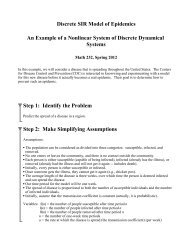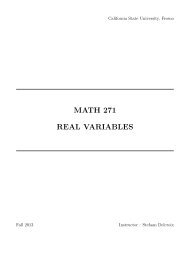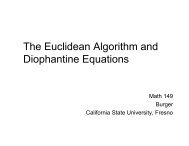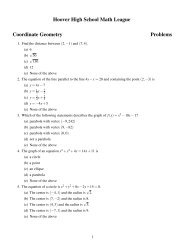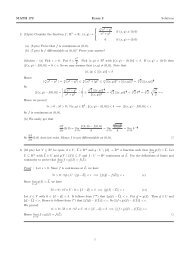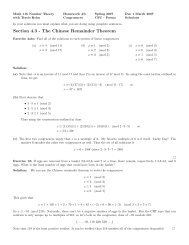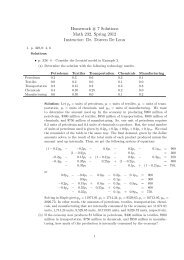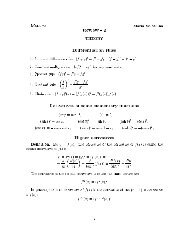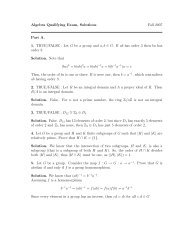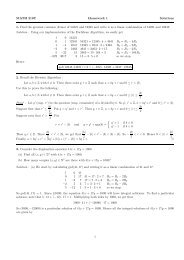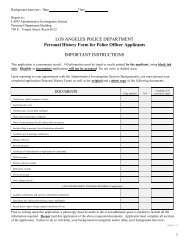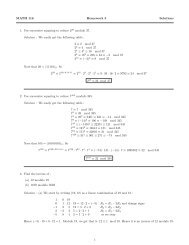Math 151 Solutions to selected homework problems Section 2.1 ...
Math 151 Solutions to selected homework problems Section 2.1 ...
Math 151 Solutions to selected homework problems Section 2.1 ...
You also want an ePaper? Increase the reach of your titles
YUMPU automatically turns print PDFs into web optimized ePapers that Google loves.
<strong>Math</strong> <strong>151</strong><strong>Solutions</strong> <strong>to</strong> <strong>selected</strong> <strong>homework</strong> <strong>problems</strong><strong>Section</strong> <strong>2.1</strong>, Problem 2(ab):In each of the following parts, determine whether the given function is one-<strong>to</strong>-one andwhether it is on<strong>to</strong>.(a) f : R → R : f(x) = x 2(c) f : R + → R + : f(x) = x 2Solution:(a) The function f is not one-<strong>to</strong>-one because e.g. f(1) = f(−1) while 1 ≠ −1. It is no<strong>to</strong>n<strong>to</strong> because e.g. −1 is not in the image (there is no real number x such that x 2 = −1).(c) The function f is one-<strong>to</strong>-one because f(x 1 ) = f(x 2 ), i.e. x 2 1 = x 2 2 implies x 1 = ±x 2 .Since x 1 , x 2 > 0, x 1 = x 2 . It is on<strong>to</strong> because for each y ∈ R + there exists an x ∈ R +such that f(x) = y, e.g. x = √ y.<strong>Section</strong> <strong>2.1</strong>, Problem 14:Let f : A → B and g : B → C be one-<strong>to</strong>-one and on<strong>to</strong>. Show that (g ◦ f) −1 exists andthat (g ◦ f) −1 = f −1 ◦ g −1 .Solution:Since both f and g are one-<strong>to</strong>-one and on<strong>to</strong>, g ◦ f : A → C is one-<strong>to</strong>-one and on<strong>to</strong>.Therefore it has a unique inverse. To show that f −1 ◦ g −1 is its inverse, we have <strong>to</strong> checkthat (f −1 ◦ g −1 ) ◦ (g ◦ f) = 1 A and (g ◦ f) ◦ (f −1 ◦ g −1 ) = 1 C . Indeed, since compositionof functions is associative, we have(f −1 ◦ g −1 ) ◦ (g ◦ f) = f −1 ◦ (g −1 ◦ g) ◦ f = f −1 ◦ 1 B ◦ f = f −1 ◦ f = 1 A and(g ◦ f) ◦ (f −1 ◦ g −1 ) = g ◦ (f ◦ f −1 ) ◦ g −1 = g ◦ 1 B ◦ g −1 = g ◦ g −1 = 1 C .1
<strong>Section</strong> 2.2, Problem 1(b):It is shown in Theorem 2.2.7 that if f : S → T is a function, then there is a one-<strong>to</strong>-onecorrespondence between the elements of f(S) and the equivalence classes of S/f. Foreach of the following functions, find f(S) and S/f and exhibit the one-<strong>to</strong>-one correspondencebetween them.(b) g : Z → Z 12 given by g(n) = [8n] 12 for all n ∈ Z.Solution:First we calculate a few images: g(0) = [0] 12 , g(1) = [8] 12 , g(2) = [4] 12 , g(3) = [0] 12 ,g(4) = [8] 12 . It appears that the images start repeating, and two integers have the sameimage if and only if they are congruent modulo 3.Proof of the above statement: g(x 1 ) = g(x 2 ) iff [8x 1 ] 12 = [8x 2 ] 12 iff 8x 1 ≡ 8x 2 (mod 12)iff 2x 1 ≡ 2x 2 (mod 12) iff x 1 ≡ x 2 (mod 12).Thus the set of images is g(Z) = {[0] 12 , [4] 12 , [8] 12 }, the set of equivalence classes determinedby g is Z/g = {[0] 3 , [1] 3 , [2] 3 }, and the one-<strong>to</strong>-one correspondence induced by g isg : Z/g → g(Z) given by g([0] 3 ) = [0] 12 , g([1] 3 ) = [8] 12 , g([2] 3 ) = [4] 12 .<strong>Section</strong> 2.2, Problem 4:Let S be the set of all ordered pairs (m, n) of positive integers. For (a 1 , a 2 ) ∈ § and(b 1 , b 2 ) ∈ §, define (a 1 , a 2 ) ∼ (b 1 , b 2 ) if a 1 + b 2 = a 2 + b 1 . Show that ∼ is an equivalencerelation.Solution:For any a 1 and a 2 , since a 1 + a 2 = a 2 + a 1 , (a 1 , a 2 ) ∼ (a 1 , a 2 ). Thus ∼ is reflexive.If (a 1 , a 2 ) ∼ (b 1 , b 2 ), then a 1 + b 2 = a 2 + b 1 , then b 1 + a 2 = b 2 + a 1 , i.e. (b 1 , b 2 ) ∼ (a 1 , a 2 ).Thus ∼ is symmetric.If (a 1 , a 2 ) ∼ (b 1 , b 2 ) and (b 1 , b 2 ) ∼ (c 1 , c 2 ), then a 1 + b 2 = a 2 + b 1 and b 1 + c 2 = b 2 + c 1 .Then a 1 − a 2 = b 1 − b 2 and b 1 − b 2 = c 1 − c 2 . It follows that a 1 − a 2 = c 1 − c 2 , thena 1 + c 2 = a 2 + c 1 , i.e. (a 1 , a 2 ) ∼ (c 1 , c 2 ). Thus ∼ is transitive.Since ∼ is reflexive, symmetric, and transitive, it is an equivalence relation.<strong>Section</strong> 2.2, Problem 12(a,b):Done in class on 9/26.2



